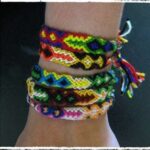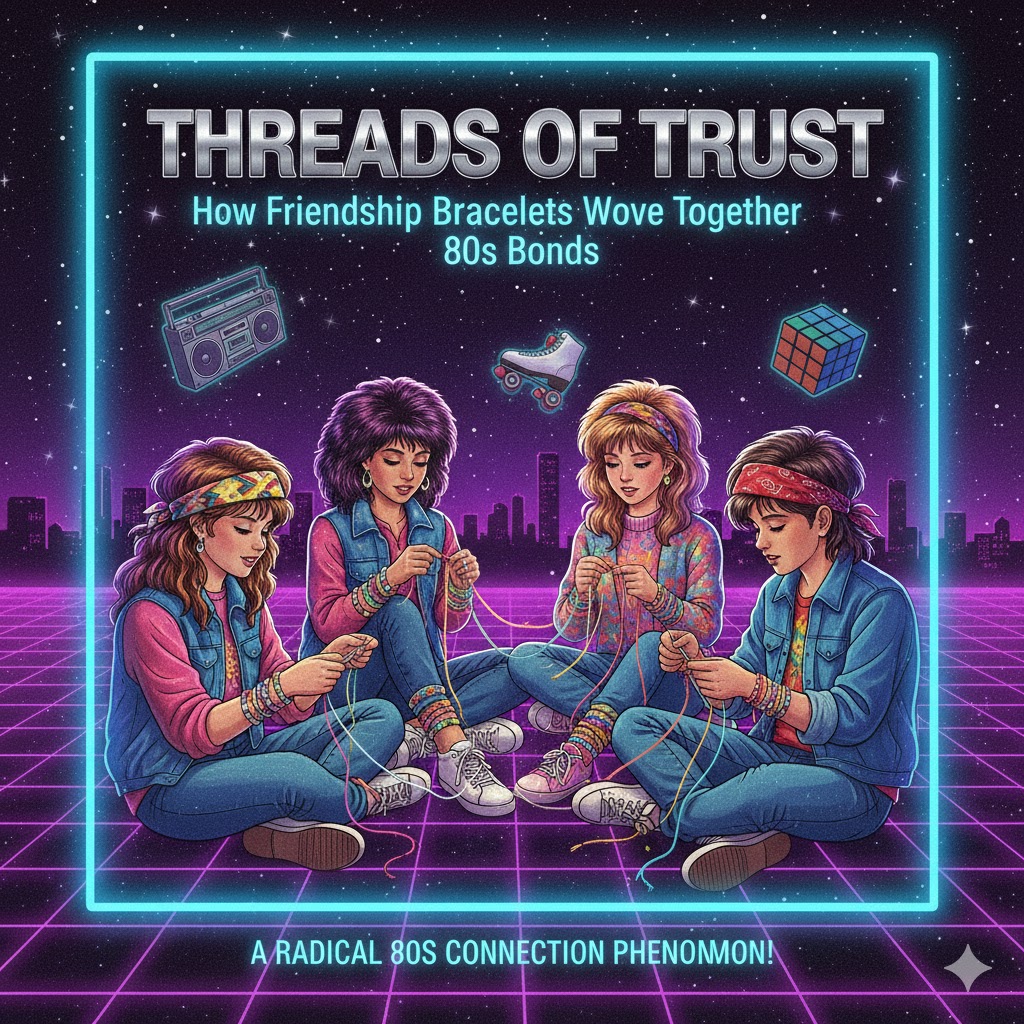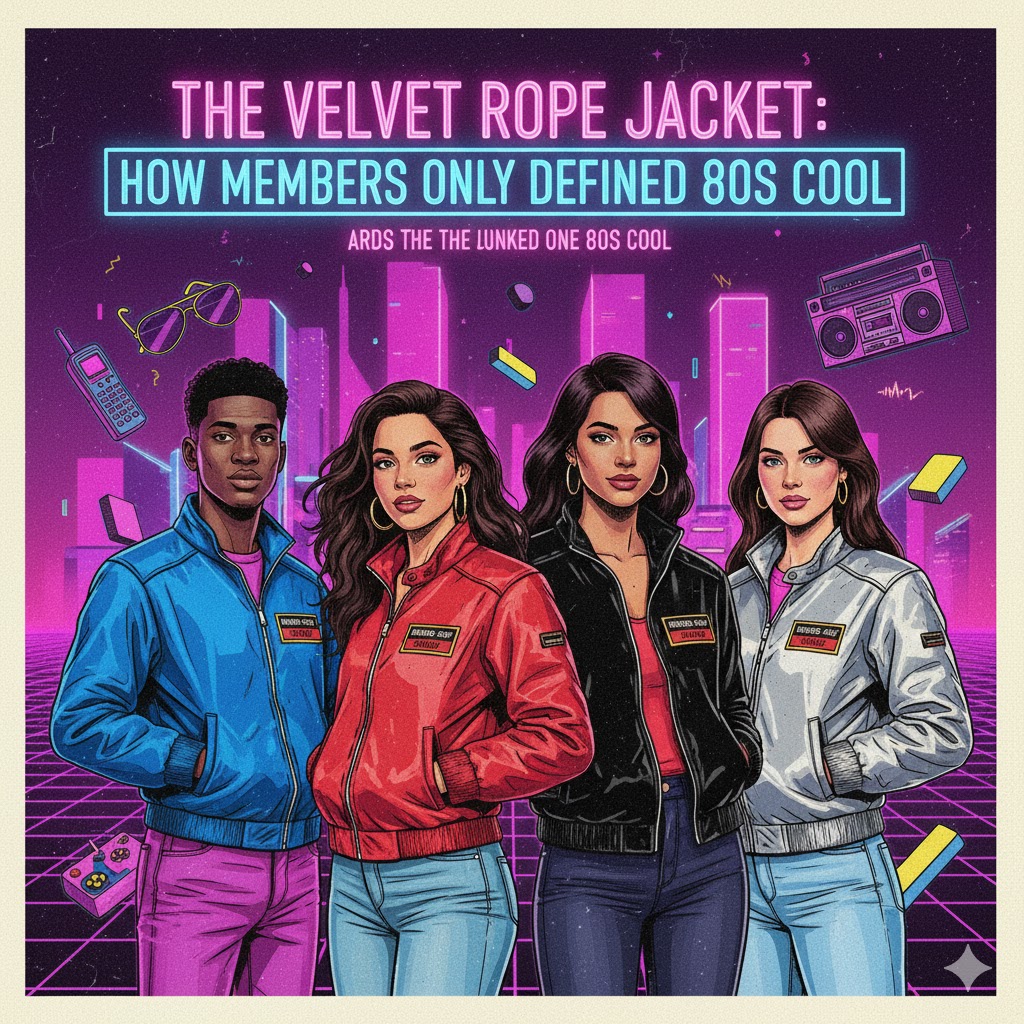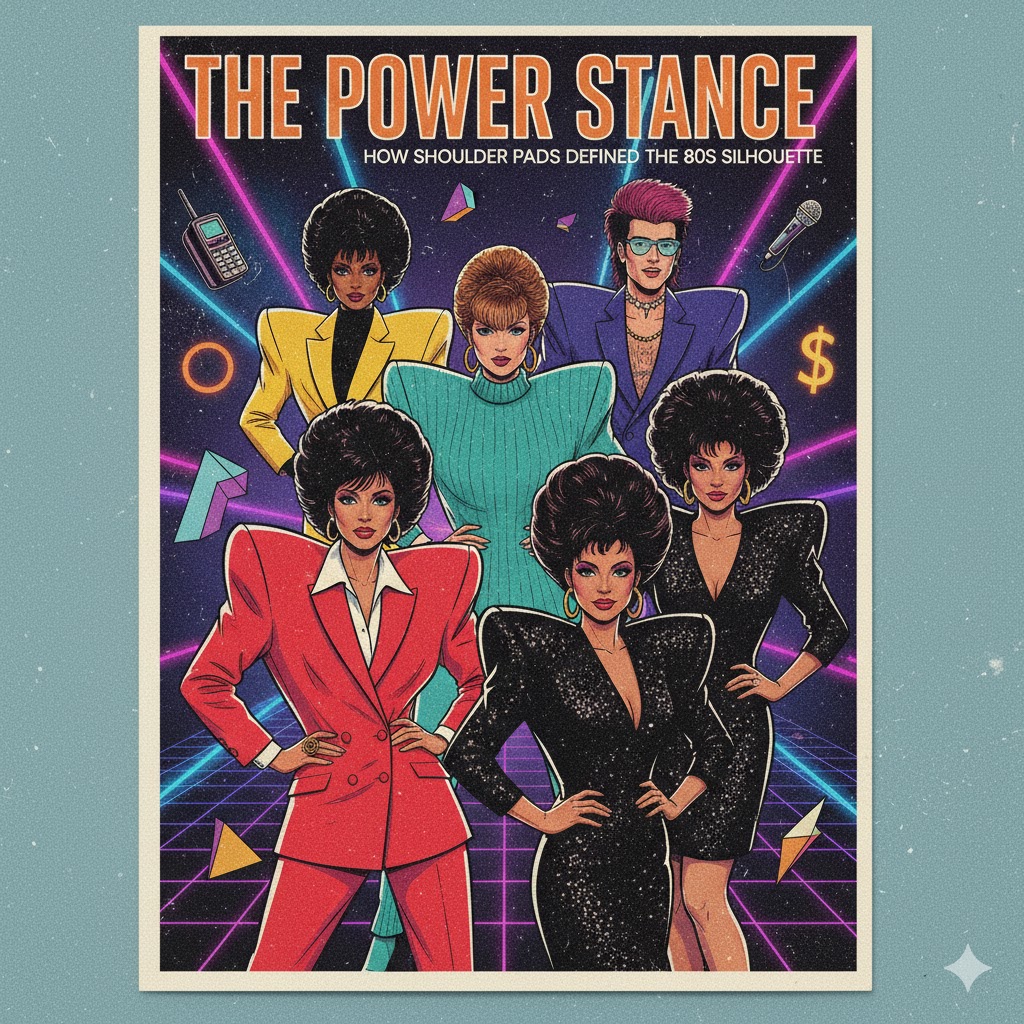 Colorful threads, intricate knots, and the simple promise of connection—friendship bracelets captured the essence of 1980s youth culture like few other trends. More than just decorative accessories, these handwoven bands became powerful symbols of social bonds, creativity, and personal expression. Across schoolyards, summer camps, and playgrounds, friendship bracelets flourished as a cultural phenomenon, representing a unique intersection of craft, fashion, and interpersonal relationships. The impact of friendship bracelets on 1980s pop culture extends far beyond the wrist; they reflected generational values, inspired DIY creativity, and became enduring emblems of childhood camaraderie.
Colorful threads, intricate knots, and the simple promise of connection—friendship bracelets captured the essence of 1980s youth culture like few other trends. More than just decorative accessories, these handwoven bands became powerful symbols of social bonds, creativity, and personal expression. Across schoolyards, summer camps, and playgrounds, friendship bracelets flourished as a cultural phenomenon, representing a unique intersection of craft, fashion, and interpersonal relationships. The impact of friendship bracelets on 1980s pop culture extends far beyond the wrist; they reflected generational values, inspired DIY creativity, and became enduring emblems of childhood camaraderie.
Friendship bracelets originated long before the 1980s, drawing from indigenous and folk art traditions in Central and South America. However, the decade saw an explosion of interest in these handmade accessories, fueled by the growing popularity of DIY culture, teen magazines, and the broader emphasis on personal expression. Children and teenagers embraced the craft, transforming a simple knotting technique into a widespread trend that transcended regional, social, and economic boundaries. Friendship bracelets became accessible to almost anyone, requiring only inexpensive embroidery floss and basic patience, making the trend inclusive and democratized in a way that few other fashion phenomena achieved.
The appeal of friendship bracelets rested on their dual nature: aesthetic and symbolic. Visually, the bracelets offered endless possibilities, from simple patterns of alternating colors to intricate chevrons, diamonds, and zigzags. Each design allowed the maker to inject personal taste, creativity, and cultural references into a wearable accessory. Symbolically, the bracelets embodied connection, loyalty, and mutual care. The act of creating a bracelet for someone else was an intimate gesture, signaling attention, affection, and friendship. Receiving a bracelet carried an emotional weight, reinforcing social bonds and personal identity during formative years. This combination of artistry and symbolism helped friendship bracelets become not just a trend, but a cultural touchstone of 1980s youth life.
The proliferation of friendship bracelets in the 1980s was fueled in part by media coverage and teen-oriented publications. Magazines like Seventeen and Tiger Beat featured step-by-step instructions for making bracelets, highlighting both fashion trends and social rituals. Television shows occasionally referenced the bracelets, and summer camps incorporated them into arts-and-crafts activities, further normalizing the practice and embedding it in collective consciousness. DIY culture was celebrated during the decade, and friendship bracelets fit perfectly into this ethos: they were creative, personal, and socially meaningful, embodying the values of self-expression and connectivity that defined 1980s youth culture.
Friendship bracelets also reflected broader trends in 1980s fashion and style. The decade emphasized bold colors, expressive accessories, and eclectic personalization, from neon clothing to scrunchies and pin-back buttons. Bracelets made of bright embroidery floss, beads, or charms complemented these fashion choices, allowing children and teens to coordinate their look with their personal style. Unlike mass-produced accessories, friendship bracelets were unique by nature. Each knot and color combination represented a deliberate choice, turning the bracelet into an extension of the wearer’s personality. This bespoke quality aligned perfectly with the decade’s celebration of individuality and creativity.
The social dimension of friendship bracelets was as significant as their aesthetic appeal. Making and exchanging bracelets became a ritualistic form of social interaction, especially in schools, camps, and youth groups. Sharing a bracelet was an act of trust, signaling the value of the relationship and commitment to ongoing friendship. Sometimes, bracelets were given with specific meanings or “rules”—for example, the recipient would wear the bracelet until it fell off naturally, symbolizing the endurance of the bond. These small social contracts embedded friendship bracelets with layers of meaning, creating a shared cultural practice that was widely understood and celebrated among peers.
Friendship bracelets were also tied to the DIY and craft movements that gained traction during the 1980s. The popularity of arts-and-crafts stores, instructional books, and hobby kits made creating bracelets part of a larger trend of hands-on creativity. Children were encouraged to explore their artistic abilities, experiment with patterns, and develop fine motor skills through the repetitive knotting process. The sense of accomplishment derived from completing a bracelet reinforced the value of personal effort and skill, fostering confidence and pride in one’s work. By merging creativity, manual dexterity, and social interaction, friendship bracelets exemplified the convergence of education and entertainment in 1980s youth culture.
Merchandising and commercialization also played a role in solidifying friendship bracelets as a cultural phenomenon. While many children made bracelets from scratch, pre-packaged kits with colored floss, beads, and instruction booklets became widely available. These kits expanded the reach of the trend, providing a convenient entry point for beginners and ensuring that the bracelets were accessible to a broad audience. Retailers recognized the appeal of personalization and interactivity, leveraging the trend in ways that reinforced both consumer engagement and cultural visibility. This commercialization did not diminish the bracelets’ personal significance; rather, it enhanced the trend’s reach, embedding it more deeply into the social fabric of 1980s youth.
Friendship bracelets also served as vehicles for storytelling and self-expression. Makers often chose color combinations to convey emotions, interests, or allegiances, creating a coded language of friendship and identity. Patterns could reflect favorite sports teams, school colors, or pop culture icons, allowing children to communicate their preferences and affiliations visually. The act of crafting a bracelet became a form of personal storytelling, turning a simple accessory into a narrative of individuality, creativity, and social connection. This aspect of the bracelets helped define them as more than a passing fad—they were cultural artifacts reflecting the priorities, aesthetics, and social dynamics of the decade.
The cross-generational appeal of friendship bracelets contributed to their cultural resonance. While primarily associated with children and teens, the bracelets were also embraced by parents, educators, and hobbyists, creating a shared intergenerational experience. Grandparents, older siblings, and camp counselors often assisted in making bracelets or taught new patterns, reinforcing bonds across age groups. The universality of the craft, combined with its social significance, helped friendship bracelets achieve a level of cultural ubiquity that few other youth trends attained during the decade.
Friendship bracelets also inspired creativity beyond the wrist. Children began experimenting with other items—anklets, keychains, belts, and bookmarks—adapting knotting techniques to new formats. This extension of the craft reflected a broader trend of experimentation and personalization in 1980s youth culture, where DIY creativity became a central component of identity formation. Friendship bracelets acted as an entry point into a larger world of hands-on artistic exploration, fostering innovation and imaginative thinking.
The symbolic value of friendship bracelets extended to emotional and social development. Exchanging bracelets reinforced empathy, trust, and commitment among peers. The rituals surrounding giving and receiving a bracelet encouraged reflection on relationships, feelings, and social responsibility. For children navigating the complexities of friendship, school dynamics, and personal growth, the bracelets provided tangible markers of connection and support. This emotional dimension amplified the trend’s cultural significance, transforming a simple craft into a powerful tool for social learning and community building.
Pop culture references to friendship bracelets also appeared in magazines, television shows, and films, further embedding them in the 1980s consciousness. Characters in teen dramas or family sitcoms were occasionally depicted crafting or exchanging bracelets, signaling both the trend’s popularity and its symbolic weight. These representations reinforced the bracelets’ social meaning, highlighting their role as markers of identity, taste, and peer bonding. Through media exposure, friendship bracelets transcended their physical form to become cultural icons, representing the values and aesthetics of 1980s youth.
The trend’s legacy endures because it captured a unique intersection of creativity, social interaction, and self-expression. Friendship bracelets exemplify how simple, accessible crafts can have profound cultural impact, shaping personal identity, peer relationships, and aesthetic sensibilities. Their popularity in the 1980s demonstrates the decade’s emphasis on individuality, hands-on creativity, and social connection, while their continued presence in nostalgia, retro fashion, and contemporary craft culture reflects their enduring appeal.
Friendship bracelets were not only about fashion or decoration—they were instruments of communication, markers of loyalty, and symbols of youthful creativity. The repetitive act of knotting threads into intricate patterns mirrored the patience, dedication, and care inherent in meaningful relationships. Wearing a bracelet, gifting one, or creating a shared set of designs became rituals that connected children to their peers, their families, and their cultural moment. This combination of tactile engagement, social significance, and aesthetic expression ensured that friendship bracelets were more than a fad; they were a defining feature of 1980s youth culture.
The bracelets’ impact is also evident in their influence on subsequent trends in DIY fashion and craft culture. The principles of personalization, hands-on creativity, and social signaling exemplified by friendship bracelets paved the way for other 1980s DIY trends, including beaded jewelry, custom clothing, and personalized accessories. These practices continue to resonate today, as modern craft movements and nostalgic recreations draw inspiration from the ingenuity and spirit of 1980s bracelet-making culture.
Ultimately, friendship bracelets’ significance in 1980s pop culture lies in their ability to transform a simple, accessible craft into a social, aesthetic, and emotional phenomenon. They offered children a means to express themselves, strengthen social bonds, and participate in a shared cultural experience. Through colorful threads and intricate knots, the bracelets captured the values, creativity, and energy of the decade, becoming emblematic of youth identity and social connection.
For anyone who grew up exchanging bracelets with friends, crafting designs late at night, or proudly wearing a wrist adorned with colorful patterns, friendship bracelets evoke memories of creativity, social bonding, and the spirit of the 1980s. They remind us that cultural impact does not always come from mass-produced media or celebrity-driven trends—it can emerge from the simplest forms of self-expression and interpersonal connection. Friendship bracelets were, and remain, vibrant symbols of a decade defined by imagination, individuality, and the enduring power of human connection.
The enduring legacy of friendship bracelets underscores how everyday objects can shape culture, influence behavior, and create shared experiences. By blending artistry, fashion, and friendship, these handwoven bands captured the essence of 1980s youth culture, leaving a tangible mark on the decade’s social, aesthetic, and emotional landscape. They were more than accessories; they were statements of identity, loyalty, and creativity, woven together with threads of color, care, and cultural resonance.
Friendship bracelets were a defining emblem of 1980s pop culture—a small, colorful, and deeply meaningful accessory that represented friendship, creativity, and the joy of making something with your own hands. Their impact continues to be felt through nostalgia, craft culture, and the enduring recognition that sometimes, the simplest gestures can leave the most lasting impressions.



